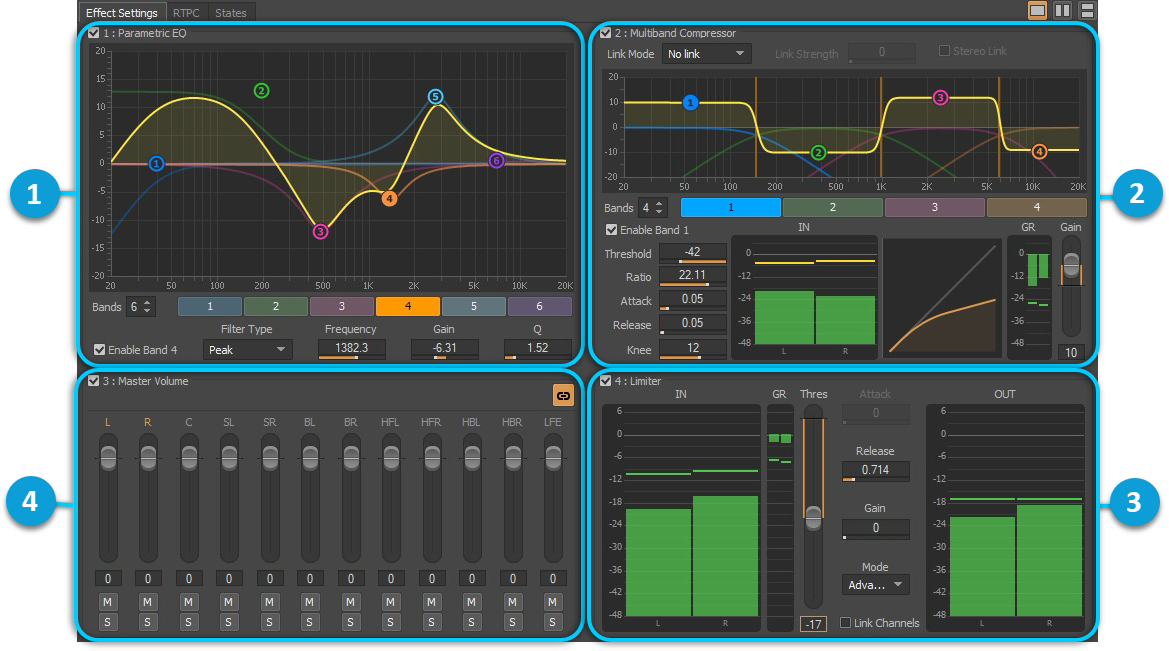The Mastering Suite is the result of a series of collaborations amongst creatives and engineers in the gaming industry. For a number of years, PlayStation has been working with the game audio developer community to design tools that provide the means to achieve the best audio quality on the platform. Audio teams and technical experts entered multiple discussions about potential ways in which an audio mastering workflow can be applied for games.
Mastering on PlayStation
Just after the launch of PlayStation 4, Marina Villanueva-Barriero, who at the time was the Principal Engineer at Sony Interactive Entertainment’s R&D Audio Team in London, began working with Worldwide Studios to create a series of mastering dsp effects that could run at the end of the audio rendering chain. The idea was simple: All games that run on PlayStation consoles, regardless of the human or technical resources, should have easy access to a series of high-quality effects that could be used to optimize the audio output.
At the time, Garry Taylor, Technical Audio Director at Creative Services Group was working with the Audio Standards Working Group to develop loudness standards for games on PlayStation 4, similar to loudness standards within the broadcasting industries. The mastering suite was the best way to achieve this, and together, Garry and Marina collaborated on developing audio presets including Home Theatre, TV, Headphones as well as a night mode.
Later, Richard Griffiths, Principal Programmer in the WWS Advanced Technology Group and is the person behind Sulpha – a Windows tool originally used for audio analysis and the PlayStation SDK synthesizer – integrated the mastering suite into Sulpha and exposed audio analysis for loudness compliance.
With Sulpha, developers would be able to make real-time changes to the mastering suite running on PlayStation 4. They can master their titles for a variety of playback systems from full range surround sound systems to TVs and headphones, with the ability to save their presets. The PlayStation SDK includes a comprehensive interactive audio mastering library, running on allocated system resources and Sulpha, to allow developers to create presets and analyse audio output.
Collaborating with Audiokinetic on a Cross-Platform Solution
It was when we met the team at Audiokinetic that we started considering to make this solution available cross-platform. The team at Audiokinetic, inspired by the Sulpha UX, took on the task to make it a reality that games running on any platform Wwise supports could benefit from the Mastering Suite. Today, all Wwise users are able to access it for free.
This is the first internal collaboration between Audiokinetic and Sony Interactive Entertainment, and I am very happy that the combined effort from our teams has facilitated in making the mastering suite accessible to the industry at large. Additionally, we will be able to introduce this fantastic arsenal of audio tools to all games using Wwise for all the different platforms that Wwise supports.
Mastering Suite Features
To allow the mastering functionality to become available across platforms, we worked with Audiokinetic to execute it as a regular insert effect plug-in on the master audio bus. Here’s a quick overview of the feature set currently available within the Mastering Suite.

|
|
6-band parametric EQ: Filter Type, Frequency, Resonance, and Gain |
|
|
4-band multiband compressor with channel linking capabilities*: Crossover Frequency, Attack/Release, Threshold, Gain, and Knee |
|
|
Soft-knee, hard-knee, and advanced limiters*: Threshold, Attack, and Release |
|
|
Master volume: Volume settings for each channel are also possible |
* Channels in the multi-band compressor can be Unlinked, Linked or Partial Link with a strength parameter..
When link mode is set to ‘Partial’, the strength parameter sets the percentage amount of attenuation that happens on channels depending on the ones that would exceed the threshold.
When your limiter mode is Advanced, the limiter can be Linked or Unlinked.
It is important to note that to preserve localisation in 3D, Linking channels is essential. More on 3D audio below.
Also note that on the PlayStation platform, the processing is offset to the low level audio system, and the process is applied after all the main game ports and the background music mixing stage. This means that the processing is done entirely on the system allocated resources and mastering has no impact on the game CPU resources. This will also be the case when Wwise is used to author games for PlayStation.
Mixing, Mastering and Presets
Mastering should be seen as a separate process to mixing, similar to how it’s done in other industries. Audio designers should have flexibility to create the most amazing audio mixes without considering the restrictions imposed by the hardware or listening environment.
The mastering suite comes with a comprehensive set of presets to facilitate audio mastering activities for those with limited resources, but Sulpha and Wwise allow you to delve into the different parameters of all the modules and create presets for different outputs.
An important part of mastering a title is to meet the required Loudness Standards. The loudness target for PlayStation titles is -24 (+/- 2) LKFS, over a measurement period of no less than 30 minutes.
Furthermore we suggest that the Loudness Range of your title does not exceed 20 LU.
3D Audio
A lot of research and development has also been done to make sure that the mastering suite works well with 3D audio.
As a user of the Mastering Suite, Loic Couthier, Supervising Sound Designer at WWS Creative Services Group, joined Marina and Garry to help update presets for 3D audio purposes and improve the features of the suite for next-generation titles. While working on ‘Hardware Rivals’, ‘Wipeout Omega Collection’ and ‘Blood and Truth’, he worked with Marina on improving the Mastering Suite’s usability. Loic is especially looking at the newer features of the next-gen platform while planning to master upcoming titles which use 3D audio functionality.
3D audio with binaural rendering uses psychoacoustics to simulate sound sources in the 3D space. Features of HRTFs include Interaural Level and Time difference and high frequency notches in the frequency domain. The mastering suite and presets within it have been developed while keeping these features in mind, and listening tests were carried out to make sure that the process doesn’t interfere with the output of the 3D audio system.
Wwise will be able to access SDK functionality on the PlayStation system ensuring the mastering is applied at the right place after all the audio rendering so that all the quality of the rendering for localised sounds is retained.
Conclusion
Finally, I am looking forward to seeing how sound designers make use of this functionality to increase the quality of the next generation of interactive audio.
We are excited about sharing this technology across a variety of platforms and will continue working on the Mastering Suite with Audiokinetic, to improve how interactive media sounds on PlayStation and all other platforms.
This was a great collaboration between Sony Interactive Entertainment’s Research and Development team, SIE Worldwide Studios (WWS), the Advanced Technology Group (WWS), Audio Standards Working Group, and Audiokinetic.




Comments